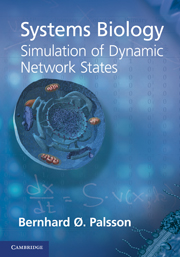PART III - METABOLISM
Published online by Cambridge University Press: 05 August 2012
Summary
The procedures laid out in Part II lead to the formulation of a MASS model-building process. The process is a step-by-step increase in the scope and coverage of a model by systematically increasing the size of the stoichiometric matrix. Mass action kinetics are assumed to represent the dynamics of the reaction rates. Typical numerical values of the concentrations and fluxes are then used to get PERCs. This leads to a condition-dependent kinetic model. The unregulated version of MASS models was covered in Chapter 8 and the incorporation of regulation was outlined in Chapter 9.
In the third part of the book we develop a series of MASS models of increasing scope for a realistic biochemical network using metabolism in the human red blood cell as an example. We begin with the classical glycolytic pathway. We then couple the pentose pathway to glycolysis to study the resulting effects. Finally, we add nucleotide metabolism to form an integrated network.
This material shows how kinetic models are built, analyzed, and scaled up to physiologically meaningful sizes based on purely network structure and available concentration and fluxomic data. Part IV will then show how the activities of protein can be incorporated into this structure.
- Type
- Chapter
- Information
- Systems Biology: Simulation of Dynamic Network States , pp. 171 - 172Publisher: Cambridge University PressPrint publication year: 2011



